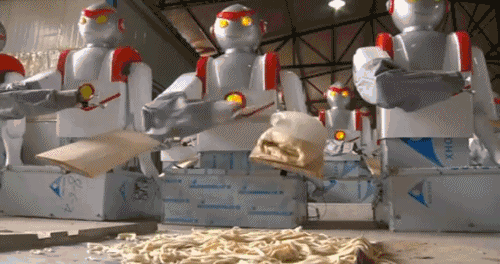The App-to-Table Restaurant

Despite the seeming multitude of delivery startups buoyed by an ocean of venture capital right now, there are really only two: a platform that allows thousands existing restaurants to get their food to people’s doors (Seamless, UberEats, PostMates, etc.) and a fully integrated machine that produces vast quantities of food in a central commissary, then delivers it to people as efficiently as possible. Maple, whose pitch is that it makes fairly healthy, fairly tasty food, created with input from chefs like David Chang and engineered to stand up to the rigors of delivery, is the best-known example of the latter. The point of this Fast Company profile of the delivery startup is largely to marvel at its growing efficiency:
When Maple launched its first location in April, it served around 50 meals per hour at peak times. Less than a year later, on average it is now serving 800 meals per hour from each of its four kitchens. A few days before I visited in February, it had set a new record: 1,100 meals cooked and delivered in one hour.
This is above and beyond the current “gold standard” of three hundred meals per hour, or one every twelve seconds, set by Chipotle. It sounds, one might think, disruptive, particularly set against the backdrop of the other efficiencies wrung out of its business model, like a greatly reduced staff (no servers!), the lack of a need for prime real estate, and finely tuned logistics coordinating everything soup to nuts, from the preparation of the food to the routes of its couriers. (These seem like minor advantages, but this is basically the recipe for how to build an establishment that will survive the capital-powered hurricane that is sweeping through the San Francisco restaurant scene.) Witness the triumph of predictive software over the Way Things Used to Be Done in the neverending battle for Greater Efficiency:
When Maple started, it based its kitchen technology on existing restaurant procedure. Its kitchen operating system centered on an app with a drag-and-drop interface that moved orders from “cooking,” “plating,” and “ready to be bundled for delivery” status, much like a paper ticket that moves down a cook line at a diner. But, says Maple cofounder and COO Akshay Navle, “It was a total waste of time to have the cook do anything other than cooking.” Now, there’s a separate app that shows cooks the predicted demand for orders (using simple machine learning techniques that base forecasts on past performance and menu mix), another that helps workers who plate dishes keep the system updated on the number of completed meals available, and a third that shows workers who bundle orders for delivery what to pack in which courier’s bags. Nobody needs to drag and drop.
This is how, Maple CEO Caleb Merkl tells Fast Company, he will be able to feed the same number of people as forty Chipotle locations with only seven Maple kitchens. “We’ve built a machine,” he says.
What is peculiar about about such an efficient machine is all of the inefficient pieces that remain inside of it, which is to say, the humans. Without getting into specific timelines about when it becomes technically feasible for certain kinds of jobs to be automated — that scale, for most jobs, is obviously measured in years or decades — what can be said, generally, is that a job is at risk of automation when it becomes cheaper or more efficient, overall, to let a machine do it instead. This is why, for instance, it is thought that busboys have little to worry about: The task would be technically difficult to automate, given that it requires a fair amount of manual dexterity and grace to clear tables while weaving, with good manners, around humans — meaning any robot that could do it would probably be expensive at the outset, so why not just keep paying the busboy minimum wage?
This is all to point out that, while an army of robot cooks is not the next step in Maple’s plan to disrupt eating or whatever, Maple is not just more incentivized than most restaurants to automate away its human work force, it is architected in such a way that automation, as it becomes technically feasible and sufficiently cost-effective, would be far easier to implement — and not just the bike messengers who will be replaced by drones as soon as Amazon’s lobbying efforts succeed. 😬
Maple’s food is highly standardized and produced at extreme volumes, and it wants — needs? — to produce it at ever-higher ones; its production, in fact, is already largely controlled by predictive software, so that the human cooks there now are, crudely speaking, algorithmically directed meat puppets. Importantly, because Maple is more like a factory than a traditional, customer-facing restaurant, replacing its cooks with Chef Boyardrones would be unlikely to cause its diners too much discomfort: Its food, like the smartphone they ordered it from, is produced entirely out of sight, so the reality of how their order is prepared or gets to them is safely obscured. Even better, no humans would be harmed in the making of this grain bowl. It’s a recipe for app-to-table cooking at its finest. 🙃
